telegraphic codes and message practice
scanned code directory
signal codes
These notes on scanned signal codes are being moved from their previous location, and here augmented. All new work on signal codes will appear here.
Eventually, all signal codes listed in my scanned code directory will be described on this page.
3 March 2014
1763 Bigot de Morogues Tactique navale, ou, Traité des Évolutions et des signaux
1803 Home Popham Telegraphic Signals; or Marine Vocabulary
1808 John Macdonald
A Treatise on Telegraphic Communication, Naval, Military, and Political
1808 Joseph Conolly
A Treatise on Telegraphic Communication by Day and Night
1816 A Code of Signals, for the Use of Merchants’ Ships in General... compiled at sea...
1817 John Macdonald A Treatise Explanatory with Telegraphic Dictionary, Numerically Arranged...
1817 Charles Lennox Sargent A system of general signals for night and day... (Boston)
1817 Joseph Conolly An Essay on Universal Telegraphic Communication... (London)
1818 Thomas Lynn An improved system of telegraphic communication. (London)
1826 Frederick Marryat A code of signals for the use of vessels employed in the merchant service (4th ed.)
1828 Richard B. Wynne A New Code of Telegraphic Signals for Yachts and Pleasure Boats (London)
1828 Henry Raper A New System of Signals, By which Colours May be Wholly Dispensed With (London) new
1832 Additional signals to Marryat’s Code, for the use of the Lintin Fleet (Canton, China)
1833 Charles L. Smartt The Hooghly River Code (Calcutta)
1835 H. Cranmer Phillipps A Code of Universal Naval Signals (London)
1835 Levin Joergen Rohde The Universal Sea Language (second edition; English translation)
1840 M. Luscombe Langue Télégraphique Universelle. Code de Signaux... (new edition, corrected and enlarged)
18–– E. et M. Luscombe Langue Télégraphique Universelle ou Code de Signaux... (no date)
18–– E. et M. Luscombe Langue Télégraphique Universelle ou Code de Signaux... (no date)
1847 Frederick Marryat A code of signals for the merchant service (10th ed.)
1851 Frederick Marryat A code of signals for the merchant service (11th ed.)
1854 Frederick Marryat Universal Code of Signals For The Merchant Marine of All Nations (12th ed.)
1857 J. T. Forster The Companion to The Commercial Code of Signals (latitude and longitude)
1868 C. W. Warden Alphabetical Code of Signals (Second edition, Calcutta)
1868 Signal Code / Semaphore Code dictionary (Convict Department, Port Arthur; date uncertain)
intro
coming. soon?
| 1763 | Bigot de Morogues, Sebastien François (1706-1781) Tactique navale, ou, Traité des Évolutions et des signaux; avec figures en taille-douce. | Paris H.L. Guerin & L.F. Delatour | google Madrid Michigan |
|
| Complutense University of Madrid copy digitized 29 January 2010 (962 pages; somewhat better scan, of the two) Michigan copy digitized 21 November 2008 (481 pages) |
||||
in two parts :
Livre Premieur — Des Évolutions. (13 chapitres).
Livre Second — Des Signaux et Ordres Généraux.
Tactique Navale is primarily devoted to tactics, but integrates signals with its presentation, so important are they to the success of naval evolutions
involving multiple vessels.
Brief notes at wikipedia; rather more in French wikipedia here.
| 1803 | Sir Home Popham (1762-1820) Telegraphic Signals; or Marine Vocabulary. | Whitehall Printed for T. Egerton, Military Library, Near Whitehall. | google NYPL VXK (Popham, H. R. Telegraphic signals) |
|
| digitized 15 June 2009 ii, [3]-113 p. ; 28 cm. at bottom of (unnumbered) page 114, this: |
||||
This is an expansion of an earlier (1800) code, which is now incorporated in a first section. To that are added two sections:
words next useful to those in the first,
which areplaced opposite to it in alphabetical order, to save the trouble of opening the book twice,
and- a third separate part (beginning at page 63), consisting of
sentences most applicable to military or general conversation. These sentences should be frequently practised to make them familiar, as they will save many signals.
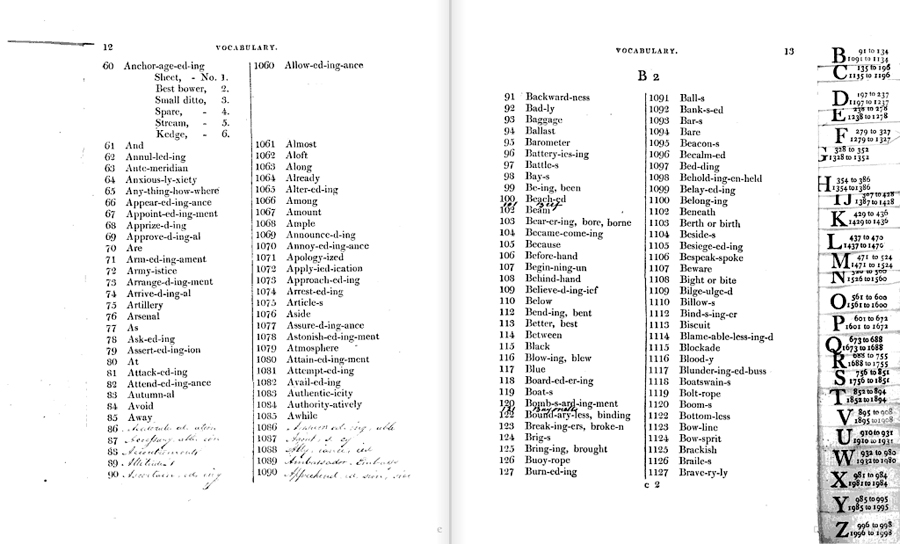 |
|
| p 12-13, showing vocabulary/flag-figure tabs, and annotations in NYPL copy. Home Popham, Telegraphic Signals; or Marine Vocabulary (1803) |
|
In the above spread, the left column on each page contains words from the earlier (1800) code, and the right column contains those words next useful
. The second and third pages of Part III are shown below. Note the second set of tabs for this separate and specialized vocabulary.
 |
|
| p 64-65, Third Part (containing specialized phrases). Home Popham, Telegraphic Signals; or Marine Vocabulary (1803) |
|
Wikipedia on the compiler here.
| 1808 | John Macdonald (1759?-1831) A Treatise on Telegraphic Communication, Naval, Military, and Political. ...in which the known defects of the present system of telegraphic practice by sea and land are obviated by the introduction of a Numerical Portable Dictionary, Calculated, when applied to various described Telegraphs, and to the Naval Flag System, to be an accurate Medium of carrying on distant Conversation, without any Liability to Confusion, Error, or Mistake: with some considerations on the present state of the marine code, and of naval signals. Illustrated by linear plates Connected with the Detail of The New Telegraphic System; Substituting, on very simple Principles, a speaking, in lieu of a spelling power, in Different Day and Night Maritime, Civil and Military Telegraphs. | Printed for T. Egerton, Military Library, Near Whitehall S. Gosnell, Printer, Little Queen Street | google Michigan |
|
| Michigan copy digitized 19 May 2009 Bodleian copy digitized 6 June 2007 |
||||
The title page includes this epigram —
frustra fit per plura, quod fieri potest per pauciora
evidently from Aristotle (and associated with Occam’s Razor), that Englished signifies It is vain to do with more, what can be done with less.
This volume includes a specimen of the Telegraphic Dictionary
, pp67-77, covering 999 terms, and of a second vocabulary consisting of expressions, not found in the former dictionary, now arranged in classes
each able to total 999 words. Macdonald’s 1817 code vastly expands these vocabularies.
Contemporary and later treatments of Macdonald’s code are dismissive and even derisory, focusing on his shutter and other mechanical devices. This is unfortunate, because Macdonald’s more interesting work is found in his vocabularies, projected in this 1808 volume, and achieved in his 1817 Treatise Explanatory. He needs to decide what expressions to leave out, and what to retain, and in what arrangement. The Treatise presents his thinking at the time of writing.
Reserving fully as much as might be necessary for naval, military, political, and commercial uses, a numerous list of words may
be rejected, as quite unnecessary to be inserted in the Dictionary; such as, technical, biblical, philosophical, legal, logical, philological, botanical, anatomical, zoological, chemical, magnetic, pneumatic, musical, optical, architectural, mathematical, agricultural, and all abstract words of erudite signification. A great number of compound verbs, such as to unchurch, to refrigerate, to obtemperate, to decorticate, to decompound, &c. &c. may be omitted. Such verbs as, to attinge, to boll, to brutify, to dehort, to enucleate, to gloze, to fizzle, to gaunch, to fudge, to unboy, to twattle, to refel, to king, &c. &c. will be useless. A large proportion of adjectives may be rejected, as ambidexter, apocryphal, boreal, debonaire, festivous, evened, facinorous, flavourous, laniginous, latrant, pharisaical, patronymical, and so on. There is a multiplicity of substantives of little or no use in, the English language, such as, ambitude, arcuation, boutefeu, expugnation, foison, infendation, occursion, parasang, and such like. The words in a common pocket Dictionary amount to about 28,000. Those in the single volume larger Dictionary may be about 60,000. All the words in the English language may amount to 70,000, or more. By rejecting all words quite unadapted to Telegraphic purposes, the number wanted might conveniently be reduced to 40,000. It is proposed, for reasons which will be stated under the description of the improved Telegraph, to divide these into Classes of 999 words in each Class. The words in each class are numbered, near the margin, from 1 to 999, inclusive. The number of each class, as class 1, or class 20, &c. is put at the top of the page, where the letters indicating the words under them, are printed, as usual.
pp 59-62
This is followed by a discussion of how inflections are to be treated, and then another of specialized classes
—
At the end of the Telegraphic Dictionary, a few useful Classes will be added. The Navy, alphabetically arranged, will constitute a Class. The Admirals, Captains, Commanders, Lieutenants, Pursers, and Surgeons, will form probably three Classes of 999 names in each Class. The names of the Officers of Marines, alphabetically arranged, will form a Class. Field-Marshals, Generals, Lieutenant-Generals, Major-Generals, Colonels, Lieutenant-Colonels, and Majors in the army, will be alphabetically disposed of in, probably, two Classes. Artillery and Engineer officers, as far as Captains, will form a Class. As casualties are liable to take place in these last four Classes, the sheets containing them may, annually, if necessary, be corrected, and easily replaced in the Dictionary. The names of oceans, seas, channels, harbours, bays, sea-ports, gulphs, islands, capes, streights, promontories, quarters of the world, remarkable sand-banks, navigable rivers, clusters of islands, anchorages, and rocks, will be alphabetically inserted in a very useful Class. Kingdoms, continents, provinces, states, counties, shires, departments, rivers, mountains, lakes, locks, passes, bridges, capital towns, towns, cities, duchies, fortresses, military or naval depots, and peoples, will afford, probably, two Classes alphabetically drawn up; and like all the others, regularly numbered. There should be two Classes, giving the Marine terms and expressions, in alphabetical order. Christian names of men, will form a short Class. The usual naval movements, manoeuvres, and procedures, are condensed into about six hundred sentences. When any one of these sentences is to be referred to, its number is signalled by means of Flags, as will be hereafter explained, in treating of naval signals. These sentences, and as many as will make up 999, will be inserted in a Class at the end of the Dictionary. A Class of sentences indicating military movements, and Field-procedure, may be found convenient. The vast number of words which can be rejected, will make ample room for the provision made for introducing the inflexions of verbs, the plurals of nouns, and the Comparatives and Superlatives of adjectives. When all the useful Classes mentioned, are added to the Telegraphic Dictionary, it will still be of a very portable size.
pp 64-65
 |
|
Pages 84-85, from A Specimen of the Telegraphic Dictionary,showing examples of the terms to be found in the Classes, as opposed to the small wordsthat precede them, in John Macdonald, A Treatise on Telegraphic Communication (1808) |
|
Entries in the Classes section would come to include phrases in the 1817 Treatise Explanatory.
| 1808 | Joseph Conolly A Treatise on Telegraphic Communication by Day and Night, for Naval, Military, and Commercial Purposes. (on new principles.) Illustrated with engravings and coloured flags; By which are exemplified the different Methods of working by regular and compound Numbers. Also is added A Numerical Inflected Dictionary of The English Language, Calculated for Communication on any Subject, and adapted to any Numerical Code. | London: Printed and Published by W. Winchester and Son, Strand. | google Michigan HE9737 .C75 |
|
Title; Advertisement (2pp); Numerical Flag Table (Plate 15); Naval Code. Of flags and pendants
pp 5-6; Of regular number pp 6-7; Of compound numbers pp 7-10 (includes a Table of Compound Numbers (Plate 16), examples of compound numbers (Plate 3); Table of numbers from 1 to 999 (with reference to compound numbers in rotation as they occur) pp 11-16; On the use of pendants, pp 17-18; On alphabetical signals p18; On hoisting and lowering signals pp 19; On auxiliary signals pp 20-22; an example (plate number obscured); Alphabetical Table (facing p23, plate number obscured); Portable, military and commercial telegraph p23; On portable signals pp 23-24; example of portable signal (plate number obscured) facing p25 —
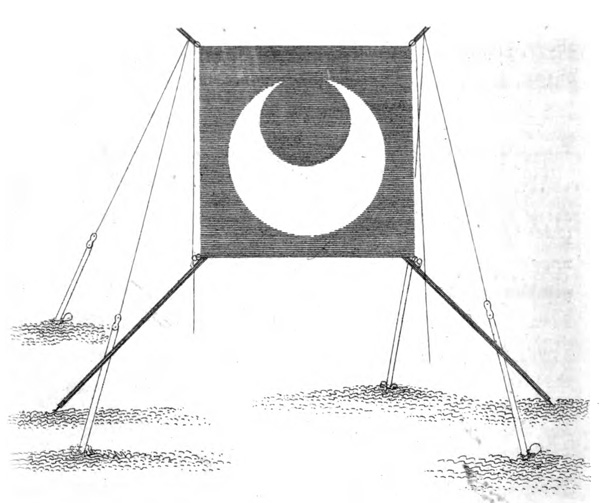 |
|
| Portable Signal, detail (Plate 13?, facing p25), Conolly, A Treatise on Telegraphic Communication by Day and Night (1808) | |
Portable telegraphic machine pp 25-27 (includes a plate); On placing the machine pp 27-28; Table (color, Plate 17) showing 1-9, (n)o or Negative, Substitute or Interrogative, and Extra Substitute or Affirmative; examples of signals (plates 7, 8 and 9); Numerical signals p29; General remarks pp 30-33; Triangular Telegraph House for Night and Day, Plate 10; Triangular Telegraph House pp 33-35; Example of Three Projections, which express How, Are, You. (Plate 11); Numerical and alphabetical house signals, pp 35-36; Telegraph house pendants pp 36-38; Night Telegraph Table (Plate 12); On different codes, belonging to the House Telegraph p39; Night telegraph pp 39-41; Numerical & Alphabetical Fixed Telegraph (Plate 18); Alphabetical Table (Plate 14);
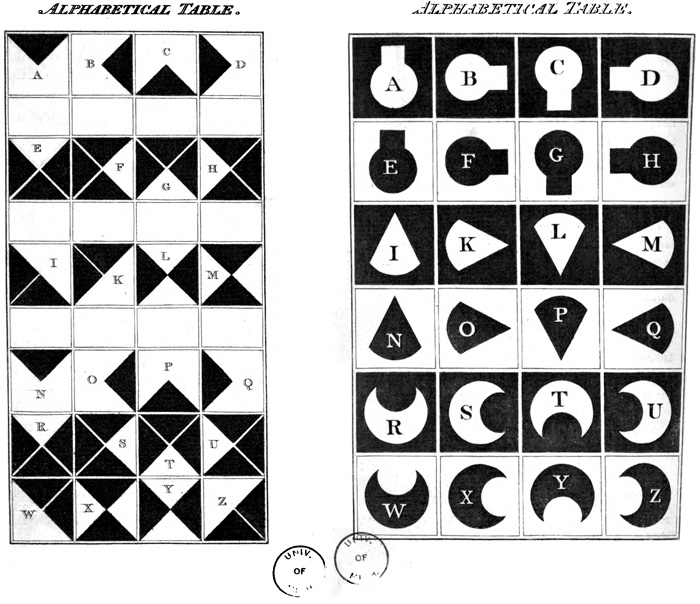 |
|
| Alphabetical Tables (two plates, obscure number at left, plate 14 at right), Joseph Conolly, A Treatise on Telegraphic Communication by Day and Night (1808) | |
Numerical and Alphabetical Stationary Telegraph pp 41-43 (includes penned correction alphabetically to numerically
); Portable Night Alphabet (Plate 13) — rather like Braille, or dominoes; Portable Night Telegraph pp 43-44; On ships’ Night Signals p44; followed by Numerical Inflected Dictionary : 1 / Aback through 10935 / Zoology (totalling 174pp of numbered vocabulary/inflections (no phrases).
See also same author’s An Essay on Universal Telegraphic Communication (1817), which restates the alphabet, provides 72 phrases (in several languages), and dispenses with the inflected
vocabulary.
| 1816 | A Code of Signals, for the use of Merchant’s Ships in general. Compiled at sea, on board the Woodbridge. | London: Printed for Robert Jennings, 2, Poultry, by James Moyes, Greville Street. 1816 | google BL 533.c.17. |
|
| viii, 168 p. 8o; preceding title page: two pages of Flags required for the merchant service. British Library copy, digitized September 16, 2014 |
||||
in brief, thus :
compass signals (showing flags) p1
months p 2
s-p-e-l-l-i-n-g p3
phrases 4-33
geographic names pp33-47
Ships’s Names, pp48-168 (many blank figures)
| 1817 | John Macdonald (1759?-1831) A Treatise Explanatory of a New System of Naval, Military and Political Telegraphic Communication, of General Application, in which a Comprehensive Numerical Dictionary...is applied... | John Macdonald. T. Egerton’s, Military Library, Whitehall. 1817 | google NYPL |
|
| NYPL copy digitized 4 November 2009 | ||||
As its title indicates, this volume contains two separate works, a treatise, and the dictionary. Each has its own title page —
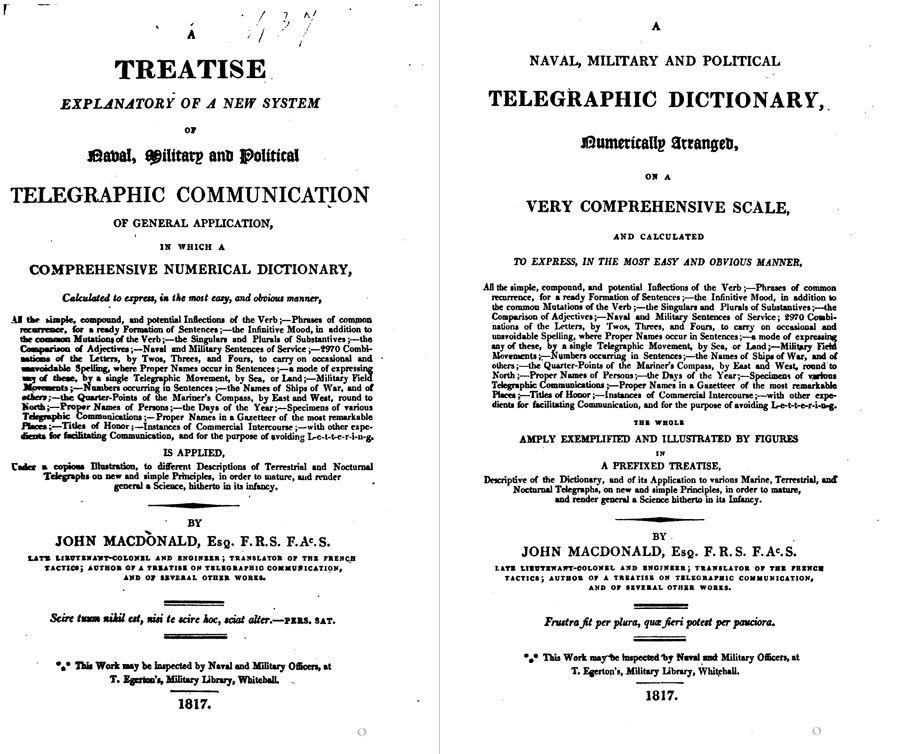 |
|
| Title pages of John Macdonald, Treatise Explanatory (1817) and A Naval, Military and Political Telegraphic Dictionary (1817), in same volume. | |
Scire tuum nihil est, nisi te scire hoc, sciat alter. — Pers. Sat.
from Aulus Persius Flaccus (34-62), a Roman satirical poet and moralist, Satire I, line 26.
Usque adeone scire tuum nihil est, nisi te scire hoc sciat alter? :
Is all your knowledge to go so utterly for nothing unless other people know that you possess it?
Frustra sit per plura, quae fieri potest per pauciora
Found in many 19c compilations, evidently related to Occam’s Razor:
It is vain to employ many means, when fewer are enough.
Macdonald’s systems were subject to criticism for being cumbersome; his anthropo-telegraph
involving five men holding flags, their actions guided by a sixth director
comes in for special derision by H. P. Mead in his The Story of the Semaphore
(Mariner’s Mirror 19 (January 1933). See also David Lyndon Woods, The Evolution of Visual Signals on Land and Sea (dissertation, Ohio State University, 1976): 49. Macdonald’s signal system may have been flawed, and his vocabulary unnecessarily large for nautical purposes. But his vocabulary is quite interesting.
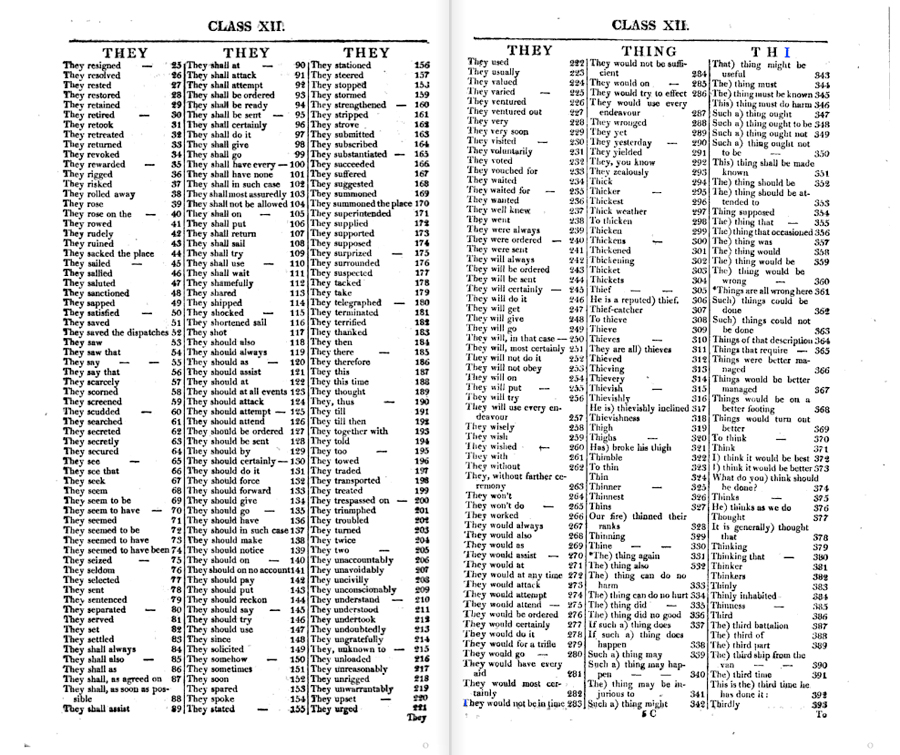 |
|
| Two pages from Class XII (they-thing-thirdly) ex John Macdonald, A Naval, Military and Political Telegraphic Dictionary (1817) | |
Macdonald arranges his vocabulary in 99 + 42 different classes (numbered 1-99, X-XL, XL-LII), each containing up to 999 instances (141 x 999 = 140,859 terms). The vocabulary contains single words and (many more) phrases; he discusses the compilation in his introduction:
It appeared a defect of the two former Dictionaries [Macdonald’s own], that frequently occuring words, such as why, where, with, if, &c., &c. were not combined, so as to form adjunct current phrases. This has been effected in the instances of such words as are printed at the tops of the columns: and these various instances are, frequently, between two and three thousand. In doing this, it became necessary to compare such words with every word in a common Dictionary, selecting such combinations as struck the mind’s eye to be of common recurrence and use. This consideration alone will enable any person to judge of the labour it required to compose the Telegraphic Dictionary.
(p9, here)
Much of Macdonald’s prefatory discussion is devoted to signals, whether land or sea. While these are of enormous practical significance, my own interest — here as elsewhere in this project — lies rather in the phrases themselves, their selection and their organization in the code book. The main phrase vocabulary contained in 99 + 11 classes (through XL 118) is followed by several appendixes (classes XL through LII), providing certain special and technical terms. Those are listed below.
- Christian names of men, alphabetically arranged; Names of women; Latin and French Phrases; Titles, and days of the months; Days of months, and remarkable days
XL 119 through XL999; - The Mariner’s Compass;
No class, but insteadCompass-Pendant
hoisted over a number, indicatingany Point, or Quarter-Point, in any direction.
Starts here. - Naval Sentences of Service
XLI 1 through XLII 333.
These are presented under italicized headings (e.g., Able, About, Abreast) to facilitate finding. Some of these sentences would appear in earlier sections of conventional signal books, and involve fewer signals. A specimen page-spread follows this enumeration of appendix content. - Marine Vocables and Phrases in addition to the dictionary.
XLII 336 through XLII 805. - A Few Terms and Vocables frequently occuring in India-Service; Hours.
XLII 806 through XLII 999. - The Combinations... reduced to practice...
XLIII 10 through XLIV 260e.g.,
Shall, or will not 253
Shall, or will not, a, an 254
Shall, or will not be 255 - Process of Spelling, When Unavoidable
Class H2, or B through H4, or D 998 - The Numeral Class
H5, or E, (six pages total) - Specimen of two modes of having Sentences of Service, conveyed by one Telegraphic Movement, from the Capitol to a Sea-Port Town.
Five pages total, starts here
not clear (to me) whether this is practical, or tentative suggestion - The Gazetteer
XLV 1 (Abbeville) through XLIVII 690 (Zyghur) - List of the Royal Navy
XLVIII 1 (Abercromby) through 815 (Zephyr) - A List of the Hon. East India Company’s Shipping, and The Bombay Marinebr> XLVIII 816-999
- Military Words, and Sentences of Service
This is a specimen of what may be done at a greater extent.
XLIX 1 through 886 - Field Movements of the Line, and A Few Field Movements of Attack
No class, but 99 signals starting heree.g.,
The line will form squares of two battalions, to resist the cavalry. 81
The line will form squares of brigades, to resist the cavalry. 82
The squares will advance. 83
The squares will retire. 84
The squares will reduce themselves into line. 86
—
Should the attack of the first line fail, it will retire through the second line, and the reserve, the cavalry covering the movement. The second line will advance to meet the first. When near the first, it will halt, and dress, as well as circumstances will admit of, previously, to moving on to the attack after the first line has passed through it. 94 - Commercial Sentences and Answers
L 1 through 109e.g.,
Lose no time in coming to town, with the bills, invoices, and all requisite papers. 8
Make minute inquiries relative to the state of the markets where the ship has come from, and forward your information. 9
—
A great bargain may be had, if you play your card properly. 48
—
We have the satisfaction to say that the ships in the following Signals have just arrived all well. 109A page-spread from this short section is the second of two specimens presented below.
The section — and code — concludes thus:
The remaining 890 numbers remaining in this Class may be similarly, or otherwise, made use of.
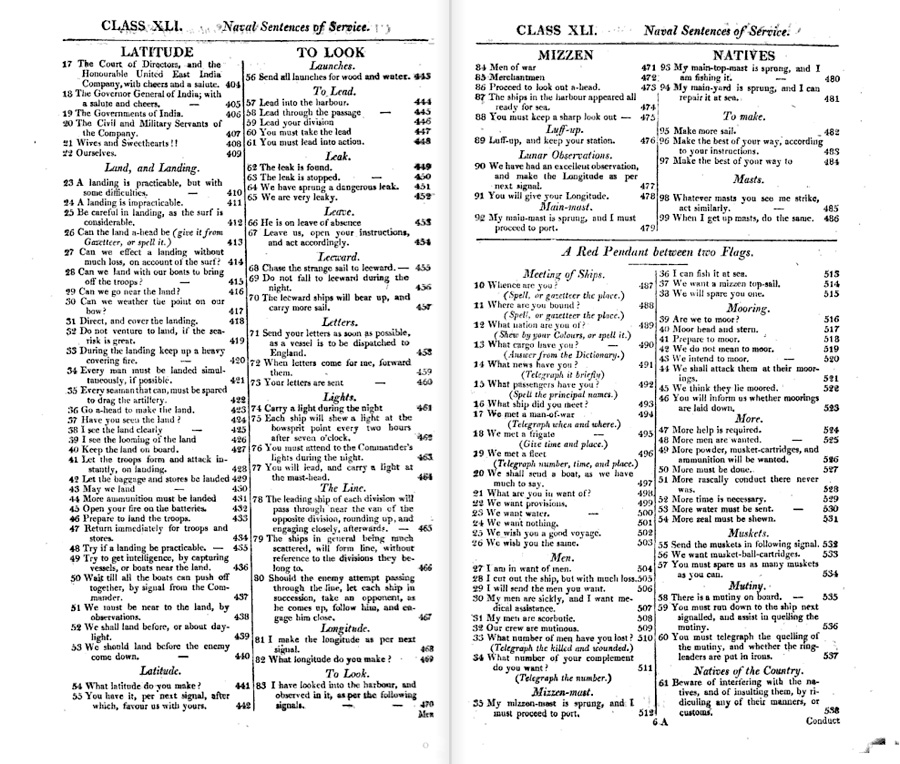 |
|
Two pages from Class XLI Naval Sentences of Service(latitude-natives-muskets) ex John Macdonald, A Naval, Military and Political Telegraphic Dictionary (1817) |
|
blah blah
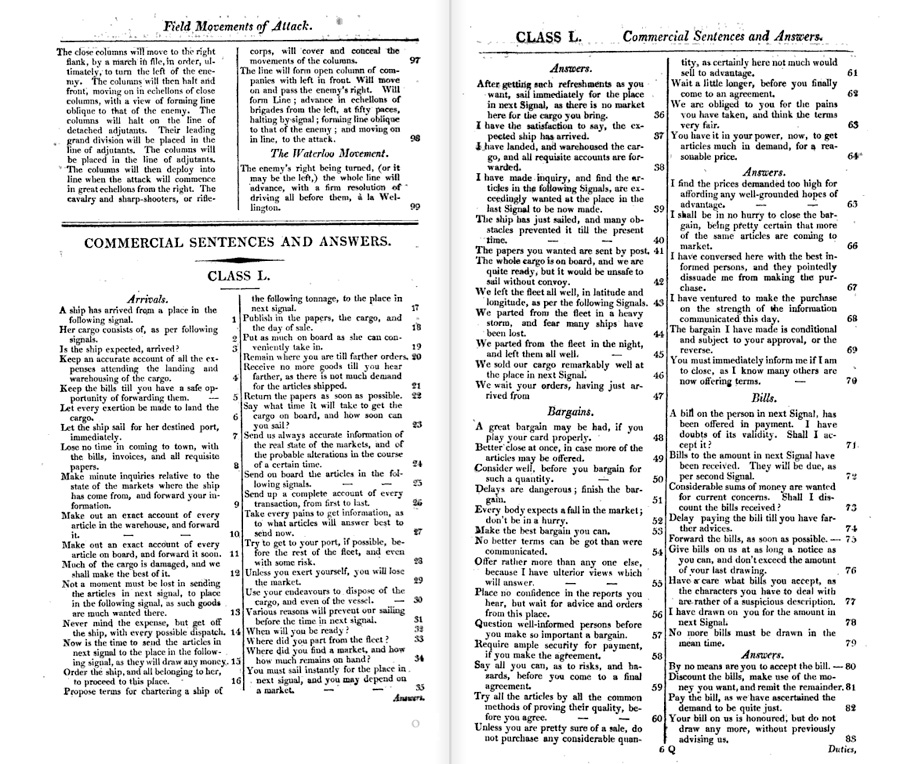 |
|
Two pages from Class L Commercial Sentences and Answersex John Macdonald, A Naval, Military and Political Telegraphic Dictionary (1817) |
|
These would seem to be specimens, as if a prospectus.
reputation, evaluation
Macdonald’s systems — both mechanical and lexicographic — were dismissed for being cumbersome. His anthropo-telegraph
involving five men holding flags, their actions guided by a sixth director
comes in for special derision by H. P. Mead in his The Story of the Semaphore
(Mariner’s Mirror 19 (January 1933). See also David Lyndon Woods, his very useful The Evolution of Visual Signals on Land and Sea (dissertation, Ohio State University, 1976): 49.
Geoffrey Wilson in The Old Telegraphs (1976) describes Macdonald (perhaps accurately) as an eccentric bore
who was obsessed with complication. He dismisses Macdonald for his long preference for the shutter method and to coding versus spelling — Macdonald remained obstinately convinced that a shutter was better than a semaphore and numbered sentences better than spelling.
Wilson proceeds then to the dictionary :
Macdonald’s Dictionary (1817) ran to hundreds of pages. Unlike an ordinary lexicon it contained thousands of phrases of which some might occur once or twice in a lifetime. For instance, there are 1,500 expressions under
great
, from great absurdity
to great wrong
and including great goose
, great rascals
and great rhapsody of nonsense
! Each would need at least five variations of aspect. If only one in five were corrupt, the received might well take in great nourishment
instead of great expectation
!
Macdonald’s signalling system(s) — and the attendent classes and 1-999 phrases for each — may have been deficient. Yet it followed from his two objectives: (1) anticipation of any likely utterance in the phrase vocabulary as struck the mind’s eye to be of common recurrence and use,
and (2), the ability to reduce the number of signals needed for the transmission of a message (to save movements), by increasing the size of the vocabulary. His Telegraphic Vocabulary anticipates the so-called verbatim codes, including Frederic G McCutcheon his enormous International Banking Corporation Telegraph Code / Phrase Tables of 1908; its emphasis on actually used phrase chunks (as judged by Macdonald), rather than fully complete sentences, seems to me pertinent to much later schemes for machine translation, involving chunks extracted from text corpora.
Thus, it was a remarkable effort at language engineering by a figure who was, ultimately, an engineer. And for this reader, its repetitions and variations make it a beautiful achivement of lexical and poetical art.
life
John Macdonald (1759-1831). His mother Flora Macdonald (1722-1790 *) was the well-known Jacobite heroine,
writes Alan Harfield in the current edition of the Oxford Dictionary of National Biography; see also the entry in the Dictionary of National Biography, vol 35 (1893) here. His military career spanned the years 1780-1806, largely with the East India Company in India and West Sumatra (Bencoolen), involving various surveying and engineering work, and experimentation with fuses.
He was better known as a military engineer and cartographer, and for his writing on subjects other than his code, including the violincello. I have been dilatory about developing a separate page to devoted to this man, whose interests were many, and whose energy was enormous.
publications
- Some Short Arguments and Plain Facts
shewing that the civilization and instruction of the natives of India furnish the surest means of upholding the stability of our oriental empire and of the introduction and speedy progress of Christianity, without arming the superstitious prejudices of the country against that cause: with an alphabetic-cipher-table for secret correspondence, and a few requisite animadversions to subjects becoming daily more prominent and commanding.
London: printed for the author by C. Roworth, Bell-Yard, Temple-Bar, 1820
here (remarkable Princeton copy, with what may be Macdonald’s own notes in back pages. - A circumstantial and explanatory account
of experiments to which is subjoined an appendix, being an exposé on the present state of telegraphic communication in this country: shewing, by correspondence, arguments, facts, and reasoning, that an interesting science, understood by few, and now attracting much public notice on the continent of Europe, and in the United Kingdom, must unavoidably remain in its present imperfect state, till the power of telegraphs is raised to the standard of the long-established Naval Numerical Plan of the expression of, at least, any three Figures simultaneously; inclusive of the adoption of Telegraphic Dictionaries, bearing the requisite Test of Comparative Trial and Experiment: and containing a Description of two Telegraphs recently invented; a succinct Account of the General Telegraphic System; with an Exemplification of its Application to Practice, &c. &c. and concluding with some animadversions to the spirit of the times.
London: printed for the author, 1819
here (NYPL copy) - violincello book?
| 1817 | A system of general signals for night and day whereby merchant vessels may communicate at a distance by means of the common colours of the ship, and with four lanterns by night, without going out of their course. | Charles Lenox Sargent | Boston: Printed by Wells and Lilly, 1817. | google Harvard Nav 578.17.2 |
| digitized July 10, 2008 | ||||
circular signals (white and black, also semicircles), also flags and lanterns; some questions, names of places, compass directions, alphabet, description of vessel, &c., provisions, orders, &c. no long phrases.
First entries are questions — (1) Whence came you? (2) Where bound? (3) How long out? ... (16) Have you had soundings, where and how much? (17) Is it peace still? (18) Who are we at war with? (19) Any cruisers on the coast? (20) What coast is blockaded?
| 1817 | An Essay on Universal Telegraphic Communication in which a plan is laid down for reciprocal intercourse between the different nations of the world in their respective languages; a principle the most simple and economical. | By Joseph Conolly, Telegraphist, author of the Telegraphic Dictionary, and other Vocabularies. | London: Winchester & Son, Strand | google Bodleian |
| digitized July 10, 2008 | ||||
Dedication (iii)-iv; Introduction (one page); two unnumbered (and possibly slipped in?) pages of phrases in Russian, 1-72; unnumbered page (loose?) of the Alphabetical and Numerical keys, bearing Bodleian size and shelflist no. 8o. B5.P.197
(?);
Alphabetical Table (Plate 5, facing p1); Universal Portable Telegraph, Explanation, pp1-5; — the entirety, including title page, repeated in French; — followed by Questions/Answers numbered 1-72, pp8-9;
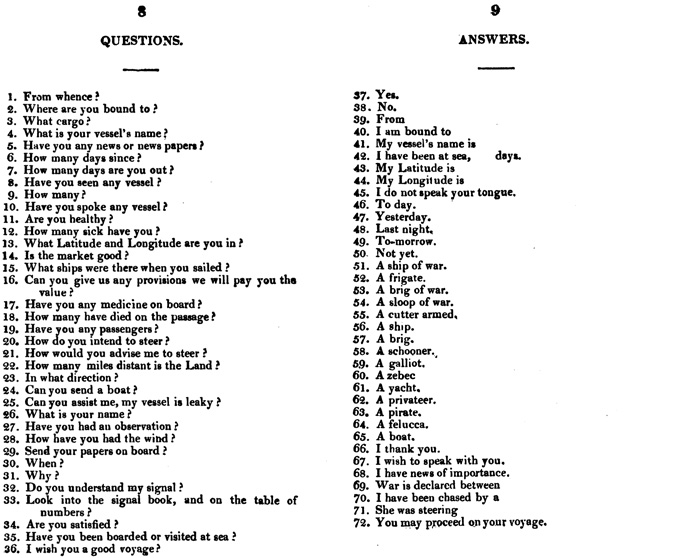 |
|
| Joseph Conolly, An Essay on Universal Telegraphic Communication (1817), pp8-9 (reformatted) | |
Demands/Reponses (1-72), pp 10-11; Question/Respuesta (1-72), pp 12-13; Preguntas/Repostas (1-72), pp 14-15; Fragen/Antworten (1-72), pp 16-17; Vraggen/Antwoorden (1-72), pp 18-19; Svar/Fragor (1-72), pp 20-21; Sporsmaal/Svar (1-72), pp 22-23; Interrogazioni/Risposte (1-72), pp 24-25; followed by blank pages, numbered 1-36 verso 37-72 verso, pp 26-45.
Emphasizes the numeric over the alphabetical code; p2 of the Introduction explains use of a (white) answering symbol denoting the affirmative, and the checquered side of the same, [denoting] the negative answer, or no.
See also same author’s A Treatise on Telegraphic Communication by Day and Night (1808). I have not seen Conolly’s The Telegraphists vade mecum, and vocabulary of the English language numerically and alphabetically arranged on new principles, etc. (London, 1817). 4o. 148pp. 3 plates.
| 1818 | An improved system of telegraphic communication.
Including a copious list of the names of places, persons, ships, articles in London price current, medicines, ship’s indent book, and an easy means of reference to Walker’s Critical Pronouncing Dictionary, whereby Every Word therein may be most easily signified, to the Exclusion of the tedious Operation of Spelling by Signal. Second Edition (Carefully revised and further improved.) | Thomas Lynn | London: Winchester & Son, Strand | google Bodleian 231.g.32 |
| digitized June 26, 2006 BL has the earlier edition : An improved system of telegraphic communications. (Continuation of the general vocabulary. Supplementary vocabulary.), London 1814. Shelfmark 534.l.29. | ||||
This book is interesting largely for the arrangement of its phrase matter. The Table of Contents does not accurately reflect the content of the book (that has no page numbers).
- Instruction to the Second Edition.
The Introduction explains the incorporation of
Mr. Walker’s stereotyped
Critical Pronouncing Dictionary at pp xxvii-xxxi, starting here. The basic idea is to indicateWalker
with a D (forDictionary
) pennant, followed by indicators for page and word-number, respectively.The examples he shows do not exactly match page number, nor even location of folios, of editions available online, but this American edition published in 1818 serves well enough. Lynn’s usage of Walker is presented as a temporary expedient: he has been called to sea again, he writes, so that publication of his work in a complete state, including
a simple system of signifying all the words of the English Dictionary,
must await another time. (pp x and xxvii). - Two-Flag Index and Vocabulary.
promised in TOC, but does not appear in the volume. - Three-Flag Index and Vocabulary.
Single words, phrases, some instructions. Some surprising entries, too — for
dear,
forlove,
thoughtless,
turtle.
S83 Turtle. 1 -s. 2 a turtle feast, 3 I will send you some turtle, 4 have you any turtle? 5 I have turtle, 6 I have no turtle, 7 a good beach for turtle, 8 send on shore and endeavor to catch turtle, 9 I intend to try for turtle, 0 there is a fine turtle close to your ship apparently asleep on the water, S come and eat turtle with me!!!
- Vocabulary of the Names of Places, &c.
(Indicated by the Red Pennant.) - Vocabulary of the Names of Persons, &c.
(Indicated by the Blue Pennant.) - Vocabulary of the Names of Ships, &c.
(Indicated by the Blue Pennant.) - Blanks for Local Significations.
(Indicated by the Blue Pennant.) - Alphabet and Spelling Table.
(Indicated by the Yellow Pennant.) - Auxiliary Verbs.
(Indicated by the Yellow Pennant.)followed by main heading Miscellaneous Matter, beginning with
- Articles In Price Current.
(Indicated by the Yellow Pennant.)Terms used in Prices Current, &c.
- Ship’s Tradesmen, Stores, &c..
(Indicated by the Yellow Pennant.)This interesting list, grouped thematically, names the trades equipment pertaining to them. The larger categories are: Ship’s Stores, Boatswain’s Stores, Carpenter’s Stores, Coopers’s Stores and Tools, Gunner’s Stores, Cook’s Stores, Ship’s Steward’s Stores, Sails and Sail-Maker’s Stores, Captain’s Steward’s Stores, and Surgeon’s Stores,
The above followed by two additional sections, not included in Table of Contents —
Instructions relative to Sails.
Two pages of coded instructions, and two pages ofSails with their respective Primes
and
This book is interesting largely for the arrangement of its phrase matter. Lynn (1774-1847) was a commander of the East India Company and author of Nautical and Astronomical Tables (1825), Horary Tables for Finding Time by Inspection (1827) and other works, hints of which can be found in the contents of the telegraphic code described here. He was also one of the authors of An Historical and Descriptive Account of China (Edinburgh, 1836), his contribution being a chapter on navigation to China.
Lynn is briefly described at the online pages to The Skilfull Seaman, An exhibition of items from the Foyle Special Collections Library to mark the 200th anniversary of the Battle of Trafalgar
(notes to Case 5). There is an entry on Lynn in the DNB.
| 1826 | A code of signals for the use of vessels employed in the merchant service; including a cypher for secret correspondence. By Captain Marryat, R. N. Dedicated to The Committee of the Society of Ship-Owners of The Port of London. To which is added, a list of the agents to Lloyd’s | 4th edn. | London, Cornhill J. M. Richardson | google HathiTrust NYPL VXK Marryat |
| digitized January 7, 2010 70 l. illus. 26 cm. |
||||
Pages not numbered. Includes three (or an unnumbered fourth) plate showing flags, plus an additional Flags for Men of War. Corresponding with those used by merchants ships. As directed by the Lords Commissioners of the Admiralty.
Preface
2 pages
Introduction
9 pages
includes Explanation of Signals
giving three examples, respectively, for
To the Agent for Lloyd’s.
Ships meeting at Sea.
and
Telegraphic Communications,
followed by
an Explanation of Cypher.
With this code as in others, no signal contains two of the same figure (or flag). Thus, 272, 273 but no 272; 6287, 6289 (but no 6288).
Part I. Names of Men at War
6 pages
Union Jack to be hoisted over the number.
1-987
Part II. Names of Merchant Vessels
First distinguishing pendant to be hoisted over the number, or at some other mast head.
26 pages.
1-6287
new ships in italic.
Supplement to Part II. Names of Merchant Vessels.
4 pages
6289-7089
Second Supplement to Part II. Names of Merchant Vessels.
12 pages (some penned additions in this scanned copy)
7091-9876
Part III. Names of Ports, Headlands, &c.
Rendezvous flag to be hoisted over the number
6 pages
1-987
Part IV. Sentences
No distinguishing flag to be used, but Numeral Flags only to be hoisted where best seen.
Signals to be used by the Pilots, Agents of Lloyd’s, or others, to Vessels in Distress, to enable them to steer into a Port or Anchorage, or avoid Dangers, when it blows so hard that they cannot be boarded.
19 pages
1 / Starboard
2 / Port
3 / Steady
—
987 / Have you a surgeon on board? I am in want of one.
Part V. First Division of Vocabulary
Compass Signals, Ship’s Stores, Auxiliary Verbs, and Final Terminations.
Second Distinguishing Pendant to be hoised over the number.
6 pages
1-35 / Compass Signals
36-309 / Auxiliary Verbs
312-706 / Final Syllables
708-987 / Wanting Stores
Part VI. Second Division of Vocabulary
The alphabet, and words most likely to be used in commercial and maritime affairs.
Telegraph Flag to be hoisted at some other mast head.
20 pages (not including a one-page explanation).
1-28 the alphabet A-Z
followed by three-column arrangement, whose first and last lines are —
| 29 Aback 30 Abaft 31 Abreast, abeam — 1287 Whale, s 1289 What | 1290 Abound, s, ing 1293 About 1294 Above — 2718 Worse, st 2719 Worthy, ily | 2730 Accumulate, s, d, ing, ion 2731 Accurate, ly, cy 2734 Accuse, s, d, ation — 4107 You 4108 Your, s, self |
followed by
List to Agents of Lloyd’s, August, 1826.
9 pages
followed by
Circulars to the Agents to Lloyd’s.
one page, thus —
The Committee for managing the affairs of Lloyd’s having been informed by the Committee of the Society of Ship Owners, that they have determined to supply the Masters of their ships with a Code of Signals, which has been compiled and published by Capt. Frederick Marryat, R. N. for the use of Vessels employed in the Merchant Service, and to recommend it for general adoption; the Committee consider it incumbent on them to furnish the Agents to Lloyd’s with Captain Marryat’s publication, in order that they may be enabled to understand Signals made by Vessels using this Code.
I am, therefore, directed to send you a copy of the same, and to request your particular attention when Signals are made; the Committee being of opinion that they may, in cases of accident, be the means of Vessels obtaining such assistance from the shore as is likely not only to tend to their safety, but, in the event of Shipwreck, to the preservation of their Crews.
I am, / Your very humble Servant, / John Bennett, / Secretary.
| 1832 | Additional signals to Marryat’s Code, for the use of the Lintin Fleet. | China trade; opium | Canton, China Courier Press | google BL 8807.ee.25. |
BL copy, digitized June 3, 2013
This short supplement to Marryat appears to be devoted to the opium trade in China. Lintin island was an early (first) entry for Europeans into China, and the Lintin Fleet was involved in the opium trade and/or smuggling. For a near contemporary account, see the long discussion on the Opium Trade in John Phipps, his
A Practical Treatise on the China and Eastern Trade: Comprising the commerce of Great Britain and India, particularly Bengal and Singapore, with China and the Eastern Islands, including much useful information, and many interesting particulars relative thereto; with directions, and numerous statements and tables, adapted to the use of merchants, commanders, pursers, and others, connected with the trade of China and India.
London: Wm. H. Allen, and Co. 1836
pages 208ff.
Pages in the code are not numbered; here is an inventory.
title page.
one table of pennants, indicating vessels in the Lintin Fleet.
Explanations
2 pages
Night signals
2 pages
Supplement to Part III. Names of Ports, Headlands, &c.
Rendevous flag to be hoisted over the number.
3 pages
11 / Achow
22 / Amoy
33 / Anjier
—
544 / Honkong
—
699 / Lintin
700 / Lintin South Sand
711 / Lintin North Sand
—
1077 / Singapore
1103 / Sing she moon
1104 / Sand, North (Malacca Straits)
1105 / Sand, South (Malacca Straits)
1163 / Yellow River
1164 / (blank)
Supplement to Part IV. Sentences.
No distinguishing flag to be used, but Numerical Flags only to be hoisted where best seen.
8 pages
phrases under the headings Anchor, Anchorage, Attack, Arrive, Boat, Barometer, Cargo, Despatch, Drifting, Engaged, Excuse, Friends, Fire, The stranger is from, Going, Letters, Line, Opium, Post, Sail, Signal, Steer, Strike, Survey, Tide, Typhoon, Vessel, Weigh.
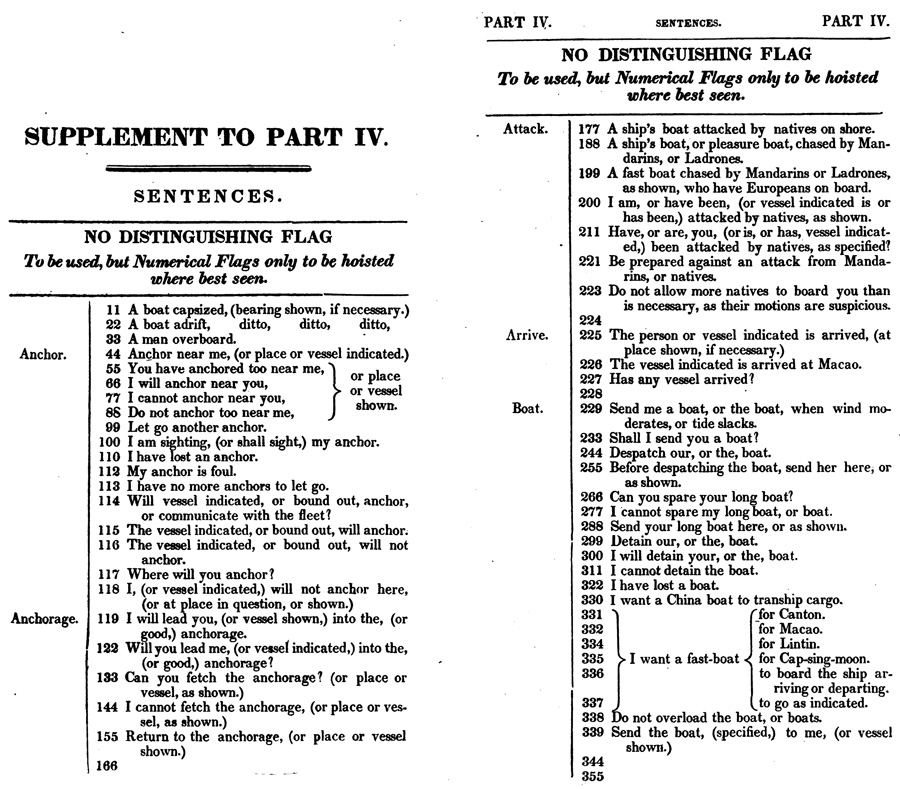 |
|
first two pages (not spread, and cropped) of Supplement to Part IV, Sentences,in Additional signals to Marryat’s Code, for the use of the Lintin Fleet (1832) |
|
11 A boat capsized (bearing down, if necessary.)
22 / A boat adrift, ditto, ditto, ditto,
33 / A man overboard.
—
177 / A ship’s boat attacked by natives on shore.
188 A ship’s boat or pleasure boat, chased by Mandarins, or Ladrones.
199 / A fast boat chased by Mandarins or Ladrones, as shown, who have Europeans on board.
200 / I am, or have been, (or vessel indicated is or has been,) attacked by natives, as shown.
211 / Have, or are, you, (or is, or has, vessel indicated,) been attacked by natives, as specified?
221 / Be prepared against an attack from Mandarins, or natives.
223 / Do not allow more natives to board you than is necessary, as their motions are suspicious.
—
500 / I am drifting, and have no more anchors to let go.
—
770 / Where are you going?
—
775 / I am going to Cap-sing-moon.
776 / I am going to Lintin.
778 / I am going to East side of Lintin.
779 / I am going to West side of Lintin.
—
911 / What quantity of opium has vessel [or indicated] brought?
922 / The ship arrived [or indicated] has brought on chests of opium — (number shown — quality shown.)
933 / Has the vessel indicated [or stranger] brought on any opium?
—
1004 / What is the price of opium, as shown [or article specified] ?
1005 / Opium [or article specified] is selling for —
1006 / Market brisk.
1007 / Market dull.
1008 / I have orders on you [or vessel indicated] for opium.
—
1128 / A sail north.
1129 / A sail south.
1130 / A sail west.
1131 / Bend sails. [If bent, unbend.]
—
1145 / Will you come and survey opium?
1146 / I am surveying opium.
1147 / The opium is ready for survey.
1148 / Is the opium ready for survey?
1149 / The opium is not ready for survey.
—
1150 / The tide is too strong.
1152 / There is no tide.
1153 / When the tide slacks, or at slack water.
1154 / Prepare for a typhoon.
—
1179 / I shall weigh next flood.
1180 / I shall weigh next ebb.
1182 / I shall weigh as soon as there is wind.
1183/ I shall weigh immediately.
1184 / Shall you weight next flood?
1185 / Shall you weigh next ebb?
Supplement to Part VI. Second division of vocabulary.
Telegraph flag to be hoisted at some other mast head.
2 pages
(names of produce, also money)
11 / [blank]
—
55 / Beetlenut
66 / Block tin, slabs
—
144 / Cutch
—
255 / Fragments, s
—
446 / Opium, Patna, new
447 / Opium, Patna, old
448 / Opium, Benares, new
449 / Opium, Benares, old
455 / Opium, Malwa, new
466 / Opium, Malwa, old
477 / Opium, Damaun, new
488 / Opium, Damaun, old
499 / Opium, Turkey
500 / Opium, Persion
511 / Opium, smuggled
—
566 / Rattans
577 / Raw silk
—
660 / Straits’ produce
—
711 / Vermillion
887 / [blank]
Part VII. Third Division of Vocabulary.
Substitute flag to be hoisted over number.
4 pages (scan repeats last two pages, yielding 6)
(places mostly, and personal names)
1 / Lintin
2 / Samarang (these are boat names)
—
213 / Jardine, W.
214 / Jardine, A.
215 / Jardine, Matheson & Co.
—
350 / Yureta Goyena, G.
—
361 / [blank]
| 1828 | A New Code of Telegraphic Signals for Yachts and Pleasure Boats. | Richard B. Wynne | Edinburgh, Printed for the Author by James Colston, 1828 | google Bodleian 28.952 |
| cm.18. digitized March 29, 2006 |
||||
unpaginated. includes these sections :
- Requisite Flags (pdf 11)
- Introduction (pdf 14-15)
- Local Table (pdf 16-21)
The following Seventeen Signals are made by hoisting the Substitute either over or under one of the flags. The Substitute is represented in the margin by the letter S.
The blanks may be filled up by such local significations or particular sentences as any two parties may previously agree upon.
This Table will be found particularly useful in communications between Steam Boats or other Vessels and their Agents on shore.[this page is lithographed (
Forrester lithog. Edin.r
shown at bottom); other pages showing penants are likely also lithographed.] - Significations Denoted by the flags when hoisted singly; and alphabet instructions (pdf 22-24)
- Part I. Distinguishing Pendants of Particular Vessels and Signal Posts. Compass Signals. Alphabet. (pdf 26-29)
- Part II. Sentences. (pdf 30-61)
In the first ninety Signals of the following division of the Code, the Substitute is hoised over the Numeral Flags, and is represented in the marginal number by the letter S. - Part III. Flag 7, Preparative.
Numeral Table. Time Table. Persons’ Names. (pdf 62-76)
When any Signal is to be made from this division of the Code, First hoist the Numeral Flag 7, as a Preparative, and when that is answered, make the intended Signal. - Part IV. Flag 8, Preparative
Sea Port Towns, Islands, Headlands, &c. (pdf 78-95)
When any Signal is to be made from this division of the Code, first hoist the Numeral Flag 8, as a Preparative, and when that is answered, make the number of the intended Signal. - Part V. Vocabulary. (pdf 98-187)
Signals made from this Division of the Code, are distinguished by having Four FLAGS hoisted at a time. - Yachts’s Names (pdf 190-211)
| 1828 | A New System of Signals, By which Colours May be Wholly Dispensed With. Illustrated by figures, and a series of evolutions, describing in a familiar manner the general movements of a fleet. | Rear Admiral [Henry] Raper | London: Saunders and Otley, Conduit Street. 1828 | google NYPL |
| digitized November 9, 2009 | ||||
elaborate (tabular) Table of Contents (between title and preface)
Preface i [wrong page]
General Instructions xiii
Instructions for the Evolutions xvi
General View, and Explanation of the System 1
Significants of the Single Flags and Pendants 8
Signals by the Admiral or Senior Officer [classes I - V]
Signals by the Ships of the Fleet [class VI. Chasing, Sounding, and Miscellaneous]
Signals by both the Admiral and by the Ships of the Fleet [classes VII-XII]
Distant Signals 91
Signals for Merchant Ships 97
Convoy Signals 101
Fog Signals 203. Instructions, p. 103; Numbers and Significations, p. 108.
Night Signals, p. 111; Instructions, p. 113; by Lanterns, p. 120; by Bluelights, p. 122; by Rockets, p. 124.
Alphabetical Index, at the end
The Table of Contents does not include the Vocabulary,
only three pages of which are provided before this explanation: The succeeding pages of the Vocabulary are omitted, as the printing of them would have increased unnecessarily the size of the Work; but, should they be required, they could be completed in a few hours. It may be proper to add, that the Geographical Table and Ships’ Names are not filled out, as they would be those in use at any given time.
The preface is basically a complaint, at Raper’s submission to the Admiralty being either unnoticed or, later, likely to be used (along with other codes) as source of a new code. and so he obtained a patent. The volume lists several errata at end; two (or more) errata/augmentations are distributed elsewhere. The TOC does not accurately reflect contents (at least for start of preface).
Henry Raper (1799-1859) has a brief entry at wikipedia.
| 1833 | Charles L. Smartt The Hooghly River Code, Adapted for General Use of the Semaphore Stations on or near its banks... | Calcutta: Printed at the Baptist Mission Press, Circular Road | google BL, Asia, Pacific & Africa T 35398 |
|
| Physical Description: vii, 106 p., [1] leaf of plates : ill. ; 22 cm. digitized August 19, 2014 |
||||
Full title —
The Hooghly River Code, Adapted for General Use of the Semaphore Stations on or near its banks, in aid of Conolly’s Vocabulary & Marryatt’s Code, and intended to facilitate communication between Saugor Island and Calcutta, on all principal subjects, likely to interest the navigator, the merchant, and the community at large. By Charles L. Smartt, of the Honorable Company’s Bengal Marine Establishment. Containing also, a short description of Conolly’s Semaphore as now used; and the method of making signals.
| 1835 | A Code of Universal Naval Signals Calculated to afford the means of Communication between Ships of All Nations; and arranged so as to be easily translated into foreign languages: in which are included Night Signals, a plan for boat signals and for a semaphore or telegraph; together with a cypher for secret correspondence. | H. Cranmer Phillipps, R.N. | London: Longman, Rees, Orme, Brown, Green, & Longman, Paternoster Row; and G. Tremlett, Bristol, MDCCCXXXV. | google Bodleian 35.777 |
| 22 cm. digitized 30 June 2006 |
||||
employs five flags — pendant, National Jack, guidon, cornette, two balls, vane and wheft.
The Flags or Symbols used in the following Signals (Plate 1);
examples (Plate 2);
Size of the Flags;
Alphabetical Index of Sentences (xiii-xviii);
Sentences (1-17);
Auxiliary Words (18-21);
Compass Signals and Bearings (22);
Alphabet (23);
Numeral Signals (24-25);
Vocabulary (explanation pp 26-28; 29-54);
Alphabetical Index to Vocabulary (55-102);
Geographical Table I (103-116);
Geographical Table II (117-127);
Geographical Table III (128-132);
Night Signals (133-137);
Fog Signals (138-139);
Signals with Bells (139-140);
Convoy Signals (141-142);
Private Signals and Cypher (143 — merely by altering the order of numbers in Plate I
);
Distant Signals (146);
Semaphore & Manual Telegraph (147-148, plus Plate 3);
Boat Signals (149-150);
Local and Pilot Signals (151);
Shipping List (158)
The sentences are arranged thematically and, as is the case with the first part of other signal codes, are devoted to distress, navigational, security and other critical communications. The explanation of the vocabulary
cautions against its use by foreigners without acquaintance with the language.
| 1835 | Levin Joergen Rohde The Universal Sea Language, being a complete code of signals for day and night. Adapted to the use of vessels of all nations, and requiring no additional flags, or means, but such as are found in every vessel, even the smallest fishing craft... Published also in Danish, French, and German. | Second edition Translated from the Danish by Captain H. B. Dahlerup, R.D.N. | London A. W. Webster, 256, Regent Street | google Bodleian 35.785 |
| digitized 4 June 2013 | ||||
Front matter pagination starts at p vi (counting from title page) through xxviii, then code proper 1-175
Flags, phrases, compound
tables.
Rohde is mentioned in David Lyndon Woods his The evolution of Visual Signals on Land and Sea (Ohio State University dissertation, 1976), but only with regard to his night signals.
Two tables of contents, as shown below.
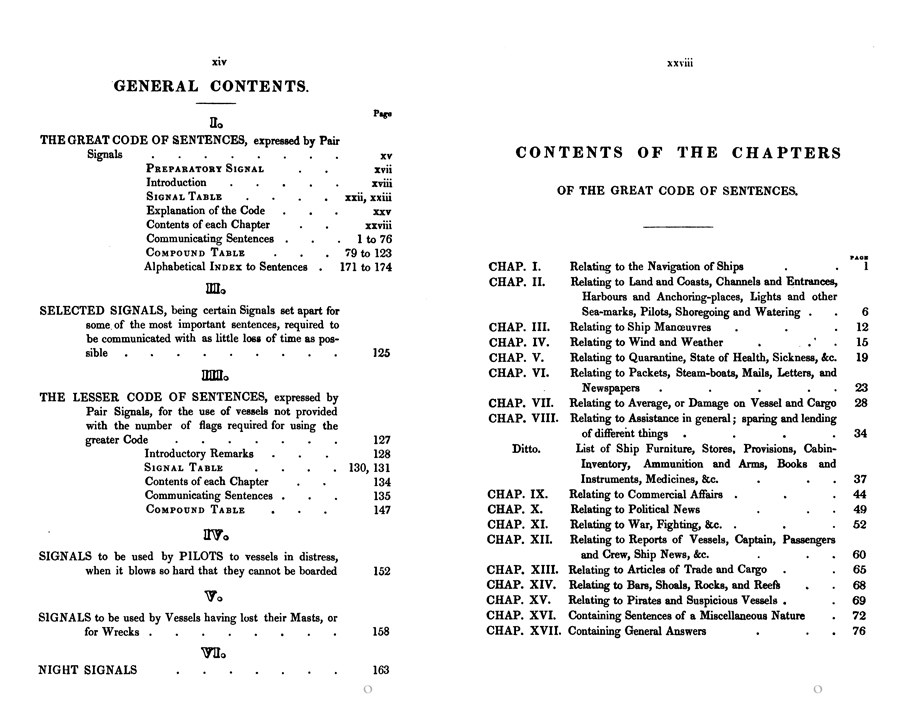 |
|
Two tables of contents, pp xiv and xxviii (not spread), the second for communicating sentences, in Rohde, Universal Sea Language (1835) |
|
Pages 1-2, of the first of 17 chapters of communicating sentences
are shown below. Answers can be composed from an answers
section and/or from the Compound Table
.
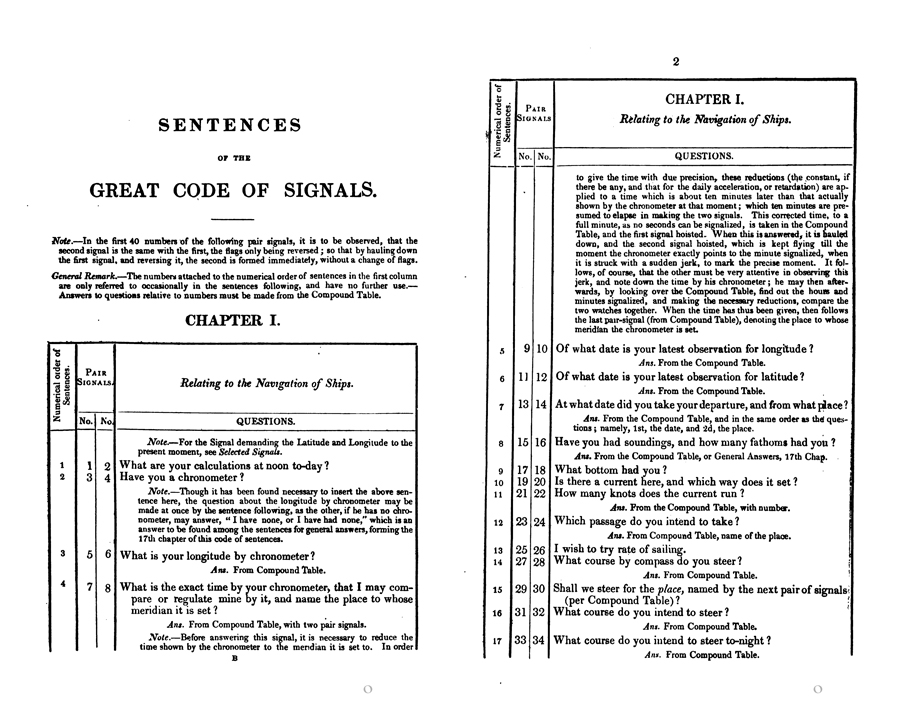 |
|
Pages 1 and 2 (not spread) in communicating sentencessection, Rohde, Universal Sea Language (1835) |
|
Shown below are the underlying flag signals for s-p-e-l-l-i-n-g and for Great and Lesser code vocabularies. The elementary signals run 1-40. —

ex Levin Joergen Rohde, The Universal Sea Language, London, 1835; pp xxii-xxiii, from google scan
Here are sentences taken from Chapter 12 in the Great Code of Sentences,
with indications for use of the Compound Table, including one instance (1245) with two usages within one sentence. A page from the Compound Table is shown immediately following these sentences. —
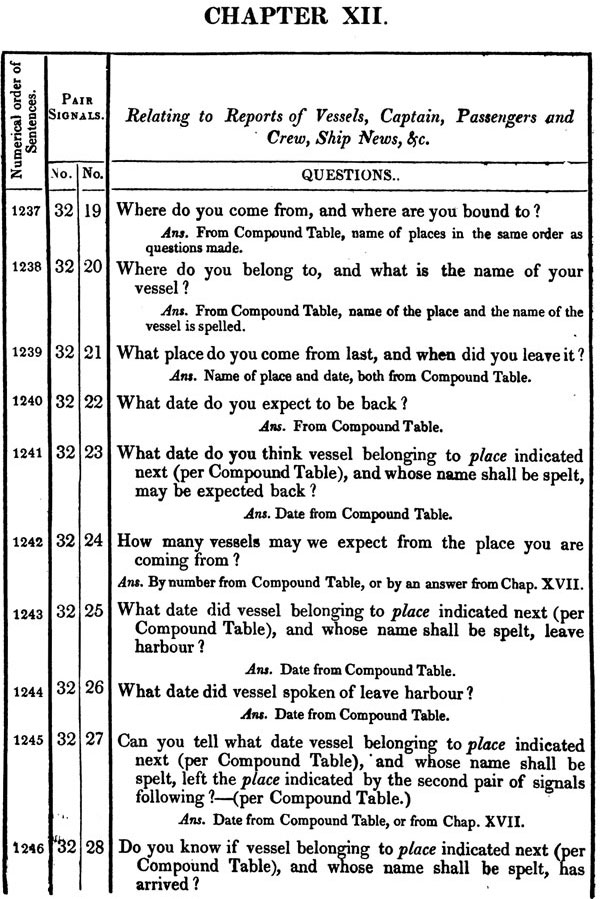
ex Levin Joergen Rohde, The Universal Sea Language, London, 1835; pp 60, from google scan
The correct meaning of the signals taken from the Compound Table will always be given in the sentence that precedes it. Some later telegraphic codes employed variations of this technique. Here is the salient passage from the Directions,
which also provide examples. —
This Table is composed of such objects of inquiry and conversation at sea, as generally require to be formed into so many different tables, with each its proper distinguishing signal; such as points of compass, date of the month, day of the week, hour of the day, degrees of latitude and longitude, names of harbours, towns, headlands, &c. The bringing of this heterogeneous matter together into one table, is founded upon the supposition, that a preceding sentence clearly shows the column of the Compound Table to which the signal made refers, or in which the answer to be given must be sought for. And though the signals for this table are the same which are used to express sentences, yet no mistake can happen, as it will always be clear from a preceding signal, whether the signal following, or the answer required, is to be looked for in the Compound Table, or not.
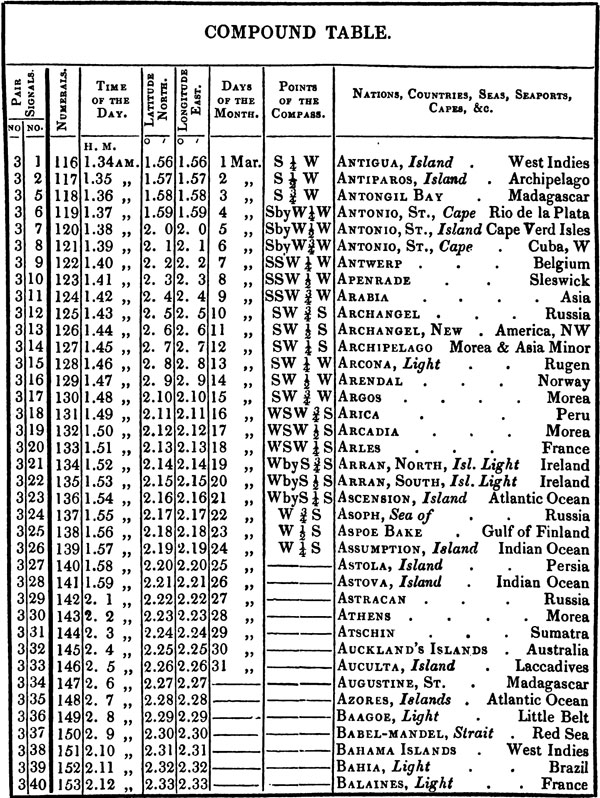
ex Levin Joergen Rohde, The Universal Sea Language, London, 1835
Here are sentences taken from Chapter 15 in the Great Code of Sentences
—
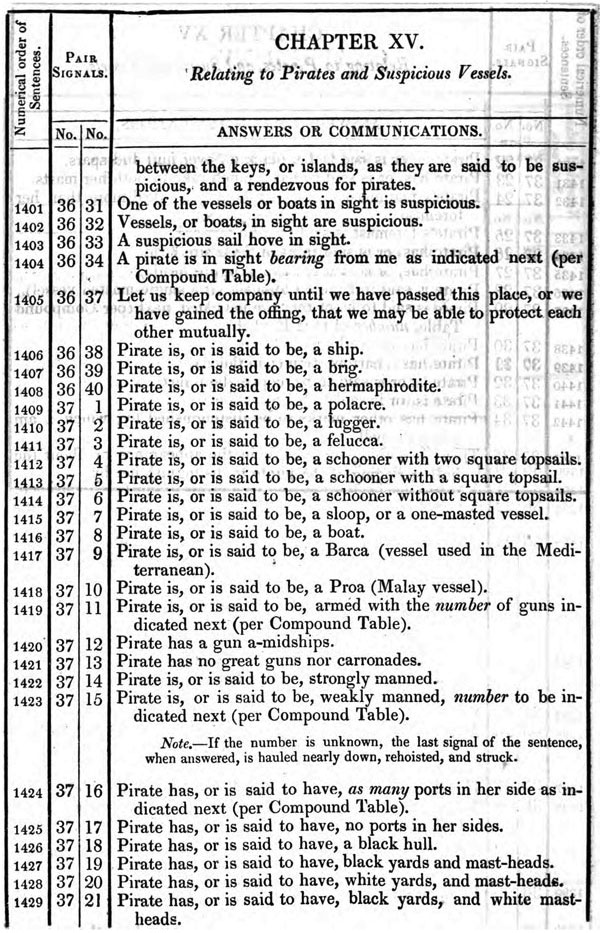
ex Levin Joergen Rohde, The Universal Sea Language, London, 1835; pp 70, from google scan
The phrase vocabulary in Rohde is rich and interesting (e.g., the sentences regarding piracy); see also pp 125-26 for SELECTED SIGNALS, being certain Signals set apart for some of the most important sentences, required to be communicated with as little loss of time as possible.
| 1840 | Langue télégraphique universelle : code de signaux adopté par les marines marchandes de France et d'Angleterre, et transmis par ordre des deux gouvernemens aux officiers des deux marines royales, pour servir a leurs communications avec les navires marchands. | Nouvelle édition corrigée et considérablement augmentée / redigée par M. Luscombe, agent de Lloyds pour les ports de la Seine et Dépendances, au Havre. | Paris, Imprimerie de Lireux Père, Rue Sainte-Anne, No. 55., Quartier du Palais-Royale | gallica BNF |
based on Marryat, same arrangement, and so includes indexes for the phrase and vocabulary sections.
| 18–– | Langue télégraphique universelle ou code de signaux adopté dans la marines marchandes d'Angleterre et transmis par ordre des Gouvernement Britannique aux ocommandants de tous les batiments du Roi pour leur servir de communication avec les navires marchands. | Adapté a l'usage du commerce maritime de la France par E. et M. Luscombe, agents de Lloyd's pour les ports de la Seine et Dépendances | Paris, de l'imprimerie de P. Didot L'Ainé, Chevalier de l'ordre Royal de S.-Michel | gallica BNF |
have yet to determine date of this code, or its differences from the 1840 code listed above.
| 18–– | Langue télégraphique universelle, ou, Code de signaux: adopté par les marines marchandes de France et d'Angleterre, et transmis par ordre des deux gouvernemens aux officiers des deux marines royales, pour servir a leurs communications avec les navires marchands. | Rédigé par E. et M. Luscombe, agents de Lloyd's. Pour les ports de la Seine et Dépendances, au Havre. | Havre, De l'imprimerie de Slas. Faure, Chavalier de l'ordre Royal de la Légion d'Honneur, Imprimeur du Roi. | google Princeton |
1822 ? (so is dated a letter of dedication to members of la Chambre de Commerce du Havre). Have not yet compared these editions.
| 1847 | Captain Marryat. A Code of Signals for the use of vessels employed in the merchant service | Tenth edition, entirely revised and corrected. | London, Cornhill J. M. Richardson | google Bodleian 47.312 |
content, shortly.
| 1851 | Captain Marryat. A Code of Signals for the use of vessels employed in the merchant service. | Eleventh edition, entirely revised and corrected. | London, Cornhill J. M. Richardson | google Bodleian 231.h.11 |
Dedicated to The Committee of the Society of Ship-Owners of the Port of London.
Note to the Eleventh Edition :
With the view of rendering this Code of Signals as complete and as perfect as possible, there has been added to the present Edition a plate of the Mercantile Flags of those nations whose Merchant Vessels are more frequently met with at sea; the list of Lighthouses has not only been much enlarged in number, but for the first time it has been rendered still more serviceable by the addition of the description of light, whether fixed or revolving, its latitude and longitude, and the number of miles at which it is visible; and to afford greater facility in reference, the Sentences have been further extended by reduplication.
content, shortly.
| 1854 | Captain Marryat. The Universal Code of Signals for the mercantile marine of all nations, by the Late Captain Marryat, R.N. with a selection of sentences adapted for convoys, and a system of geometrical signals. | Twelfth edition | London, Cornhill J. M. Richardson | google Bodleian 231.h.12 |
This introduces a second distinguishing pendant, to accommodate the increased number of Merchant Vessels requiring distinguishing numbers.
content, shortly.
| 1857 | The Companion to The Commercial Code of Signals, for the use of all nations; making the flags used in that code available for interchanging the latitude or longitude, in degrees and minutes, by one signal of three flags; also tables of longitude assimilated to the meridians of Amsterdam, Cadiz, Greenwich, & Paris, rendering the indication of ship’s reckoning instantly available for navigators of all nations. (In two parts.) | latitude or longitude | London Charles Wilson | google BL 8805.f.11. |
| digitized 4 June 2013 Scan incomplete, and some pages duplicated or out of order. Latitude Signals pages are missing entirely from online scan, and one page only — p(8) — found in pdf (TKM / 65º 0' > WNV / 74º 59'). Of Longitude Signals pages, only the following are present: 9 : Ball to be hoisted over the flags : Longitude East BCD / 0º 0' > CDR / 4º 59'; Longitude West CDS 0º 0; > DGM / 4º 59' 18 : Ball to be hoisted under the flags : DGN / 85º 0' > GKW / 94º 59' All longitude |
||||
Scan may be faulty, or represent an incomplete copy (submitted for provisional copyright protection ?), or a combination of both. I have not checked against original at BL.
It was only in 1884 that the International Meridian Conference adopted the Greenwich meridian as the universal Prime Meridian or zero point of longitude. *. Before then, maritime states reckoned longitude from different meridians (generally being their capital city). The Companion enables users of different nations, each with their respective meridians (Greenwich, Amsterdam, Cadiz and Paris), to encode their, and decode others’, longitudes with ease and absence of error. As its preface explains —
It therefore becomes necessary, when the longitude is signalized by a British, French, Dutch, or Spanish ship, to add or subtract to or from places, the adopted meridians of which are east or west of each other.
In the tables, Part II., the longitudes will be found assimilated in every case, so that no more is necessary than to ascertain the nationality of the vessel making her longitude known by signal, or otherwise, and to compare it with the longitude reckoned from the meridian adopted by the observer, to arrive at the same position on the chart.
page vii.
Observations on signalizing are detailed at pp vii-viii, and provided in abbreviated fashion, in seven languages, at pp 9-11. In English, they run thus:
Directions for exhibiting and deciphering the signals.
These Intimations of Reckoning are distinguished from other Signals, because a Ball always forms part of the hoist.
The National Ensign must be shown when making a Signal.
Any Latitude is signalized in Degrees and Minutes by hoisting the Flags representing the Letters placed against it in Tables Part I., with the ball between the Flags, see Examples 1, 2,3, and 4.
Any Longitude is signalized in like manner, the Ball being over or under the Flags, see Examples 5, 6, 7, and 8.
The Ensign denotes what Meridian is used; and in Part II., against the Longitude signalized, will be found the Longitude of other Meridians, all of which describe the same place on the Chart.
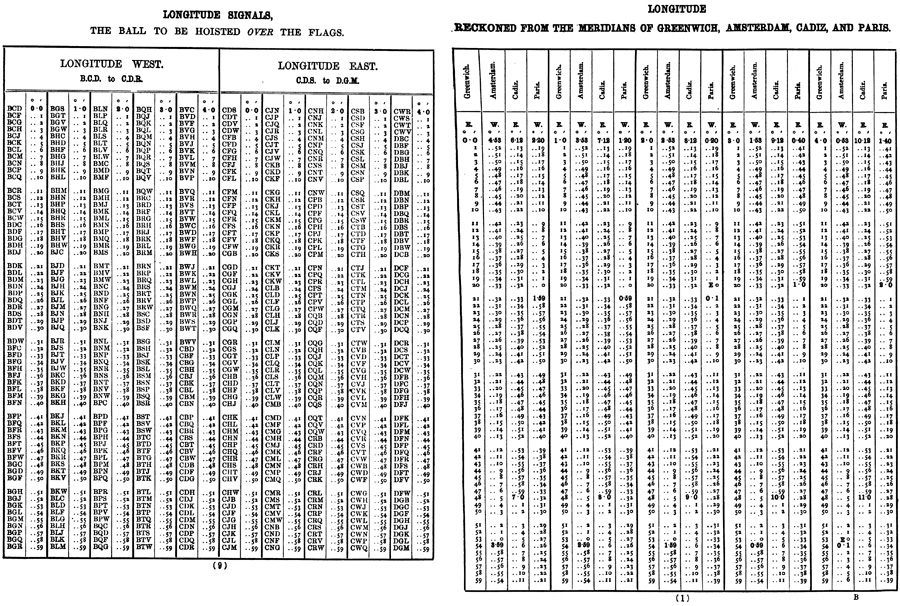 |
|
| at left, first (of seven) longitude pages in Part I (uniquely giving separate signals for East and West); at right, first (of 72) pages in Part II, in which longitudes of four different meridians (Greenwich, Amsterdam, Cadiz and Paris) are ranged next to each other. in Companion to The Commercial Code of Signals (1857) |
|
The system cannot work if the ensign showing a signalizing vessel’s nationality is not displayed.
. . . 1858 Ward’s Code of Signal Telegraph, for Ocean Marine Service, alphabetically arranged Auburn, N.Y. googlewith all the principal seaport towns, light-houses and islands in the world, with their latitudes and longitudes, including North American Lake and River Navigation.
William Henry Ward,
inventory of the Marine Telegraph,patented bullet-and-shell moulding machine, turn-tables, etc.Auburn, N.Y.: Published by the Author, 1858
original at NYPL
System and mechanism, no vocabulary. Twelve (12) pages only — introductory material — of a volume whose table of contents covers pp 14-287. See entry for Ward’s The Ocean Marine Telegraph (1861).
original at Bodleian (231.e.46)
pp5-8 Instructions for using the "Lights" for Night Signals
This system is so well adapted for spelling, that good operators would prefer it to code-books for maintaining continuous communications.
The following Tables will serve to illustrate the indications, without reference to the Plates — and should be committed to memory...
followed by pages (including unscanned plates) on the fog signals and their use.
followed by title page reading :
Seventh Edition of Ward’s International Prize-Medal Signal Telegraph. Illustrated. / London: W. H. Ward, 24, Union Square, N., and Auburn, New York, United States... 1863), followed by plates 1-3 of Ward’s Night Signals (employing 7 lantern positions), followed by pages devoted to Ward’s Bullet Machine, Shell Moulding Machine, and Self-Centering Railway Turn-Table.
Soon to add Tasman Peninsula, Signal Code / Semaphore Code dictionary, a dictionary or code book of semaphore codes used by signal stations between Hobart and Port Arthur (pertaining to handling of convicts).
Date uncertain: 1868?
catalogue description
signal code
(16 June 2018)
| 1868 | C. W. Warden. Alphabetical Code of Signals for the use of government pilot, surveying, light, buoy, and other vessels, telegraph stations, &c. | Second edition. | Calcutta: Office of Superintendent of Government Printing. 1868. | google BL (India Office Library) Asia, Pacific & Africa V 6763 |
| x, 271 p. : ill. ; 25 cm.
British Library copy, digitized August 19, 2014 |
||||
The present system of letters
shows a decided improvement
over the previous 1845 edition, which employed a flag numeral system.
18 signals with one flag.
306 with two flags
the remainder (1,098) shown with three.
This edition has some three or four hundred more sentences requiring only three Flags.
uses Marryatt’s flags, but so arranged, that it is not possible for a sentence in the Pilot’s Code to be made, which, on looking into Marryatt’s Signal Book, could convey any sense of its purport; there is therefore no possibility of confusion.
Preface to the Second Edition, i-ii
Explanation of Parts of Code, iii-iv
General instructions, v-viii
Addenda, viiia-viiib
River Surveyors’ Signals
Part I Principle officers of the State, also Pilot Service. (many names handwritten), pp 1-9
Part II Government Vessels, pp 11-13
Part III. Names of Buoys. (some lovely names), pp 15-29
Part IV. Names of Places, Creeks, Marks, &c. (lovely names, e.g., Sumatra Sand, Jar Makers, Jar Makers’ Reach, Jar Makers’ Point, Jiggercolly, Kidderpore Dock...), pp 31-61
Part V. Sentences, pp 63-244 (the major part of the code)
(Part V, continued) River Surveyor’s Signals, pp 245-256
Part VI Compass Signals, pp 257-266
Part VII Night Signals, pp 267-271
| 1868 | Convict Department, Port Arthur, Signal Code / Semaphore Code dictionary "a dictionary or code book of semaphore codes used by signal stations between Hobart and Port Arthur" (pertaining to handling of convicts). | manuscript | CON133/1/1 Tasman Peninsula - Semaphore Code dictionary | catalogue description scan |
| 75 folio spreads, hand written;
"The code book is organised in two sections - alphabetically by word; the second part is numerical." |
||||
fuller description to follow (16 June 2018)
The Wikipedia description of the penal colony at Port Arthur is chilling.
Tasmanian Archives Online / list of convict department holdings
Agency Details
Agency Number: TA60
Title: CONVICT DEPARTMENT
Start Date: 01 Jan 1818
End Date: 31 Dec 1877
Description:
The Convict Department was part of the Imperial (as distinct from Colonial) establishment and was directly responsible to the Governor. By 1871 the number of Imperial convict (or ex-convicts in lunatic asylums) was so few that they were transferred to colonial custody, though their costs continued to be met out of Imperial funds.